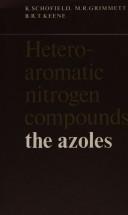| Listing 1 - 10 of 33 | << page >> |
Sort by
|
Book
Year: 2021 Publisher: London : IntechOpen,
Abstract | Keywords | Export | Availability | Bookmark
 Loading...
Loading...Choose an application
- Reference Manager
- EndNote
- RefWorks (Direct export to RefWorks)
Azoles are a broad and promising class of five-membered heterocyclic compounds containing from one up to five nitrogen atom(s) that can also contain sulfur or oxygen atoms. Widely used as potent antifungal agents, various azole derivatives have also demonstrated many other promising biological properties. This book covers studies of several types of thiazole-based heterocyclic scaffolds, the development of 4-thiazolidinone and thiazole derivatives with heterocyclic fragments as potential candidates for new drugs against trypanosomiasis, numerous synthetic approaches for the synthesis of 1,2,3-triazoles, the application of N-azole, N,S-azole, and N,O-azole as well as their derivatives as retarders of metallic corrosion, and the integration of azoles in materials used for renewable energy processing and applications and wood treatment.
Book
Year: 2021 Publisher: London : IntechOpen,
Abstract | Keywords | Export | Availability | Bookmark
 Loading...
Loading...Choose an application
- Reference Manager
- EndNote
- RefWorks (Direct export to RefWorks)
Azoles are a broad and promising class of five-membered heterocyclic compounds containing from one up to five nitrogen atom(s) that can also contain sulfur or oxygen atoms. Widely used as potent antifungal agents, various azole derivatives have also demonstrated many other promising biological properties. This book covers studies of several types of thiazole-based heterocyclic scaffolds, the development of 4-thiazolidinone and thiazole derivatives with heterocyclic fragments as potential candidates for new drugs against trypanosomiasis, numerous synthetic approaches for the synthesis of 1,2,3-triazoles, the application of N-azole, N,S-azole, and N,O-azole as well as their derivatives as retarders of metallic corrosion, and the integration of azoles in materials used for renewable energy processing and applications and wood treatment.

ISBN: 0521205190 Year: 1976 Publisher: Cambridge Cambridge University press
Abstract | Keywords | Export | Availability | Bookmark
 Loading...
Loading...Choose an application
- Reference Manager
- EndNote
- RefWorks (Direct export to RefWorks)
Book
Year: 2021 Publisher: London : IntechOpen,
Abstract | Keywords | Export | Availability | Bookmark
 Loading...
Loading...Choose an application
- Reference Manager
- EndNote
- RefWorks (Direct export to RefWorks)
Azoles are a broad and promising class of five-membered heterocyclic compounds containing from one up to five nitrogen atom(s) that can also contain sulfur or oxygen atoms. Widely used as potent antifungal agents, various azole derivatives have also demonstrated many other promising biological properties. This book covers studies of several types of thiazole-based heterocyclic scaffolds, the development of 4-thiazolidinone and thiazole derivatives with heterocyclic fragments as potential candidates for new drugs against trypanosomiasis, numerous synthetic approaches for the synthesis of 1,2,3-triazoles, the application of N-azole, N,S-azole, and N,O-azole as well as their derivatives as retarders of metallic corrosion, and the integration of azoles in materials used for renewable energy processing and applications and wood treatment.
Book
ISBN: 9781032099255 9781420066074 9780429145933 Year: 2021 Publisher: London : Taylor & Francis,
Abstract | Keywords | Export | Availability | Bookmark
 Loading...
Loading...Choose an application
- Reference Manager
- EndNote
- RefWorks (Direct export to RefWorks)
The number of different chalcogenadiazoles and their structural diversity make it difficult to gain a clear understanding of the subject by studying an individual system in isolation. "Chalcogenadiazoles: Chemistry and Applications" emphasizes general features of this class of heterocyclic compounds. It concentrates on properties of each class of chalcogenadiazoles and their cycle-fused derivatives, considering chemical reactions of functional groups only in cases when these reactions permit to characterize the heterocycles as substituents or in respect of its aromaticity.Covering an important and rapidly developing branch of heterocyclic chemistry, this book is an essential resource for students, young professionals and experienced specialists in adjacent fields.
Azoles. --- Chalcogenides. --- Chalcogénures. --- Azoles.

ISBN: 0471078271 Year: 1980 Publisher: New York (N.Y.): Wiley
Abstract | Keywords | Export | Availability | Bookmark
 Loading...
Loading...Choose an application
- Reference Manager
- EndNote
- RefWorks (Direct export to RefWorks)
Triazoles. --- Triazoles --- Pyrrodiazoles --- Azoles

ISBN: 0471046566 Year: 1981 Volume: . 37 Publisher: New York (N.Y.): Wiley
Abstract | Keywords | Export | Availability | Bookmark
 Loading...
Loading...Choose an application
- Reference Manager
- EndNote
- RefWorks (Direct export to RefWorks)
Triazoles. --- Triazoles --- Pyrrodiazoles --- Azoles
Book
ISBN: 1839681802 1839681799 Year: 2021 Publisher: London : IntechOpen,
Abstract | Keywords | Export | Availability | Bookmark
 Loading...
Loading...Choose an application
- Reference Manager
- EndNote
- RefWorks (Direct export to RefWorks)
Azoles. --- Thiazoles. --- Azoles --- Organosulfur compounds --- Heterocyclic compounds --- Organonitrogen compounds

ISBN: 0471039934 9780471039938 9780471041269 Year: 1979 Volume: 34/1-3 Publisher: New York (N.Y.): Wiley
Abstract | Keywords | Export | Availability | Bookmark
 Loading...
Loading...Choose an application
- Reference Manager
- EndNote
- RefWorks (Direct export to RefWorks)
Thiazoles. --- Thiazoles --- Azoles --- Organosulfur compounds

ISBN: 9781848160422 1848160429 1860941729 9781860941726 Year: 1999 Publisher: River Edge, NJ : Imperial College Press,
Abstract | Keywords | Export | Availability | Bookmark
 Loading...
Loading...Choose an application
- Reference Manager
- EndNote
- RefWorks (Direct export to RefWorks)
This book deals with polypyrazolylborates (scorpionates), a class of ligands known since 1966, but becoming rapidly popular with inorganic, organometallic and coordination chemists since 1986, because of their versatility and user-friendliness. They can be readily modified sterically and electronically through appropriate substitution on the pyrazole ring and on boron, and have led to a number of firsts in coordination chemistry (first stable CuCO complex, first monomeric MgR complex, and many other such firsts). Their denticity can range from two to four, their "Bite" can be adjusted, and add
Scorpionates. --- Pyrazoles. --- Azoles --- Polypyrazolylborates --- Organoboron compounds --- Pyrazoles
| Listing 1 - 10 of 33 | << page >> |
Sort by
|

 Search
Search Feedback
Feedback About UniCat
About UniCat  Help
Help News
News